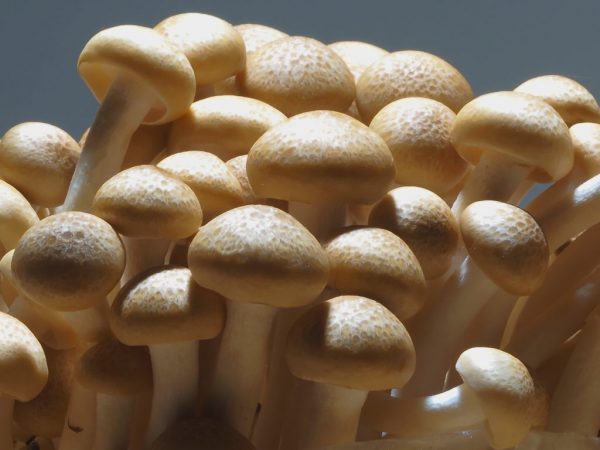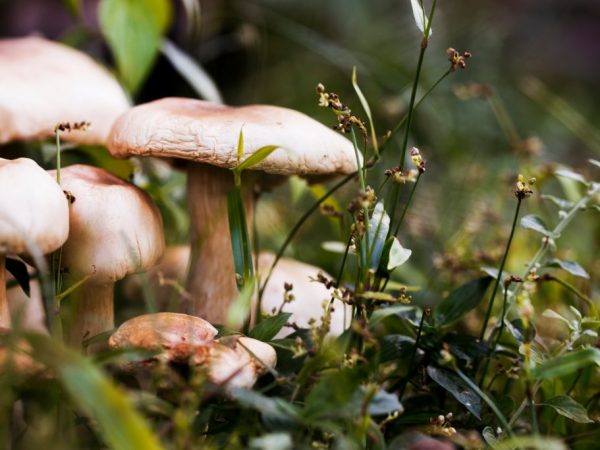The chemical composition of mushrooms
The use of mushrooms in cooking is justified not only by the excellent taste of this product, but also by the rich chemical composition. Fruit bodies contain many nutrients that are necessary for humans, and vegetarians replace meat with them. The composition of the mushrooms varies slightly depending on the species.

The chemical composition of mushrooms
Useful substances in the composition of mushrooms
The chemical composition of mushrooms is not similar to the composition of any other product. They contain from 5 to 10% dry matter. The rest is water. The product is rich in protein, it makes up 65-70% of the total amount of substances. Mushrooms also contain carbohydrates, the amount of which is about the same as in other plant foods. They are rich in vitamins A and C, in the chemical composition there are vitamins of group B, D, and PP. During cooking, some of the vitamins are destroyed, which is why the products are not recommended to be subjected to prolonged heat treatment.
There are no less vitamins in the composition of mushrooms than in beef liver.
There are few minerals in the product. Potassium, copper, iron, calcium, sodium, rubidium, tin, cadmium, molybdenum, chromium, sulfur are present. In minimal amounts, it is included in the fruiting body of the fungus and silver. Although the amount of trace elements that make up the chemical composition of mushrooms is small, they are enough for a person to receive more than half of the daily intake of necessary substances.
The nutritional value
There are fewer useful substances in the chemical composition of mushrooms with age, which is why it is better to bypass old specimens. Depending on the variety, the calorie content varies between 9-35 kcal for every 100 g of fresh product, which makes mushrooms popular with nutritionists. A representative of the genus Bolet - boletus - is high-calorie. The smallest number of calories is found in nigella. On the contrary, 100 g of dried product contains from 150 to 320 kcal. The same goes for homemade pickles. It is difficult to judge the calorie content of store products due to the fact that their chemical composition has a high content of all kinds of additives.
Irina Selyutina (Biologist):
In terms of their chemical composition, almost all mushrooms resemble a mixture of meat and vegetables. Therefore they are called "forest meat" or "forest bread". It is estimated that dried mushrooms contain about 30% protein (however, young mushrooms have more than old ones). In terms of protein content and amino acid composition, mushrooms are closer to vegetables. They are composed of 18 out of 20 protein-forming amino acids. Of these, 8 are irreplaceable, i.e. they are not synthesized in the human body.
Since the cell walls of fungi include the polysaccharide chitin, which is not absorbed in the human gastrointestinal tract, it is necessary to cook the mushrooms in such a way as to release the contents of the cell to the maximum, which the human body can handle. To do this, fresh mushrooms are finely chopped, and dry ones are ground. Both are thermally processed, which makes it possible to increase the assimilation of the pulp of the mushroom, or rather, the proteins it contains, up to 70%.
The fruiting body of the fungus contains a large amount of lipids, which is 1.3-2.7%, this figure is several times higher than the amount of fat in vegetable crops. Polyunsaturated fatty acids, irreplaceable (not synthesized) for the human body, make up about 67% of the mass of lipids. They ensure the normal development of tissues, metabolism and do not allow cholesterol to settle on the walls of blood vessels.
The main part of the carbohydrates contained in the mushroom body belongs to the fiber fraction and normalizes the intestinal microflora and helps to remove cholesterol and toxins from the body.
The ratio of proteins, fats and carbohydrates (kbzh or bzhu) varies greatly depending on the species. So, for example, 100 g of fresh boletus contains 3.7 g of proteins, 1.7 g of fat, 3.4 g of carbohydrates. The calorie content is 30 kcal. Dried boletus, devoid of water, contains 20.1 g of proteins, fats and carbohydrates are 4.8 g and 27.6 g, respectively. Calorie content - 150 kcal. The highest rates are in dried boletus boletus. They contain 35.4, 5.4, 39.7 g of proteins, fats and carbohydrates, respectively. The calorie content is 240 kcal. The indicators are low for fresh oils. With an energy value of 9 kcal, they contain 2.4, 0.7, 1.7 g of proteins, fats and carbohydrates. It is not possible to list all the varieties of kbzh. There is a table on the product packages that displays such information.
The time for the digestion of a product of any kind (type) in the human gastrointestinal tract remains unchanged. It is 150 minutes.
When cooking, it must be borne in mind that not all parts of the mushroom have the same nutritional value. So, in the caps there is less mushroom fiber, so they are more easily absorbed by the human body. The legs, on the other hand, are less digestible due to the presence of a large amount of fungin in them, which gives strength to each cell of the fungus. In old mushrooms, it is recommended to remove the spore-bearing layer - it is of nutritional value only in young specimens before the formation of spores. The skin covering the cap also needs to be removed, because most often it is in it that harmful substances are collected by the "close team".
Mushroom groups

By taste, mushrooms are divided into four groups.
According to the nutritional value and taste, all mushrooms are divided into 4 groups. The 1st group included boletus, pine mushroom and r. spruce, cultivated champignon. By the way. All species, in which the leg and cap are painted white, have high taste. Boletus, boletus, milk mushrooms (blue, aspen) and boletus are included in the 2nd group, their nutritional value and taste are slightly inferior to Boroviks. Russula (not all), honey agarics (autumn) and Valui are assigned to the 3rd group. Mushroom pickers take them less often. The 4th group includes oyster mushrooms (common, autumn), podgruzdki (white, black) and russula (not all). If you cook them correctly, you get delicious and healthy dishes.
Interesting Facts
To get the most out of a food, it must be cooked properly. It is also better to know about the special properties of mushrooms:
- Mushrooms contain small amounts of minerals, including calcium. But this microelement is absorbed a little better if you serve a mushroom dish with sour cream or milk.
- The protein content of mushrooms is high. To get its daily allowance, 250 g of fresh boletus or half of this portion of dried boletus is enough. Their systematic use leads to an improvement in the functioning of the cardiovascular and immune systems. Also, mushrooms contain substances that can prevent the appearance of various neoplasms in the body, which is why they are recommended as a cancer prevention.
- Mushrooms, the composition of which includes vitamin C and carotene, are deprived of these substances during prolonged heat treatment. The optimal cooking time is no more than 10-15 minutes. Therefore, it is better to cook dishes from small mushrooms, which are cooked in the oven for 7-10 minutes.They should not be eaten raw. This can cause gastrointestinal disturbances.
- Mushrooms are not only about protein or carbohydrates. In laboratory conditions, substances are obtained from them, which are used for the preparation of medicines. In particular, antibiotics (penicillin, for example) and antibacterial drugs are made from them. In folk medicine, drugs for alcoholism and pain relievers are made from edible mushrooms. Used by folk healers and inedible species. However, it is better to refuse to accept such funds.
- The presence of zinc in mushrooms makes the product valuable during the diet. This trace element in the composition of the fruit bodies allows you to accelerate carbohydrate metabolism. As a result, all food is digested and calories do not add excess weight. With a lack of zinc, a person wants sweets or alcohol. It will be more useful to make up for this deficiency with the help of mushrooms that will not harm the figure. Also zinc improves potency.
- The enzymes found in mushrooms help normalize blood cholesterol levels. Oyster mushrooms cope with this task best of all. To lower blood cholesterol levels by 10%, 50 g of oyster mushrooms are included in the daily diet.
- Of the enzymes capable of breaking down fats and glycogen in fungal cells, amylase, lipase, cytase, uretase were found.
- The largest amount of fat is found in the hymenium, less in the leg.
Mushroom damage
Mushrooms are carbohydrates, protein, enzymes and other substances necessary for the normal functioning of the body. However, in some cases they pose a danger to human health. Due to the peculiarities of their chemical composition (for example, the presence of chitin in the cell wall), mushrooms are difficult for the digestive system, and many enzymes are required for their processing. Because of this, they are not given to children and the elderly. People with gastrointestinal diseases should first consult with their doctor.
It is better to collect these gifts of the forest yourself. The content of toxic substances in edible mushrooms growing near highways and enterprises is high. They absorb many substances from the environment like sponges. Collect the product in ecologically clean areas.
Mushrooms are absorbed only 2.5 hours after consumption, so it is better to eat them for breakfast or lunch. To avoid flatulence (bloating), they are not combined with fresh vegetables. It is better to remove the shell covering the cap before cooking. They go on a "quiet hunt" with the appearance of the first spring rains. With enough water, the mushrooms grow rapidly. It is important to be in time before the mushroom, which is 90% water, loses most of its nutrients.
Conclusion
Do not ponder whether the mushroom is a protein or a carbohydrate. The composition of mushrooms includes all components, not excluding fats, enzymes and essential oils. Both fresh and moisture-free mushrooms are useful. Dried mushrooms are higher in calories, which should be taken into account by people counting calories and keeping a food diary. When harvesting, it is worth taking care not to take inedible specimens in the total mass, which pose a mortal danger.


